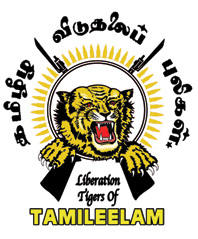| |||||
| Decades: | |||||
|---|---|---|---|---|---|
| See also: | |||||
The following lists events that happened during 1986 in Sri Lanka .
| |||||
| Decades: | |||||
|---|---|---|---|---|---|
| See also: | |||||
The following lists events that happened during 1986 in Sri Lanka .

The Liberation Tigers of Tamil Eelam was a Tamil militant organization, that was based in the northern and eastern Sri Lanka. The LTTE fought to create an independent Tamil state called Tamil Eelam in the northeast of the island in response to violent persecution and discriminatory policies against Sri Lankan Tamils by the Sinhalese-dominated Sri Lankan Government.

The Sri Lankan civil war was a civil war fought in Sri Lanka from 1983 to 2009. Beginning on 23 July 1983, it was an intermittent insurgency against the government by the Liberation Tigers of Tamil Eelam led by Velupillai Prabhakaran. The LTTE fought to create an independent Tamil state called Tamil Eelam in the north-east of the island for the Tamil Sri Lankans.

The 1987–1989 JVP insurrection, also known as the 1988–1989 revolt or the JVP troubles, was an armed revolt in Sri Lanka, led by the Marxist–Leninist Janatha Vimukthi Peramuna, against the Government of Sri Lanka. The insurrection, like the previous one in 1971, was unsuccessful. The main phase of the insurrection was a low-intensity conflict that lasted from April 1987 to December 1989. The insurgents led by the JVP resorted to subversion, assassinations, raids, and attacks on military and civilian targets while the Sri Lankan government reacted through counter-insurgency operations to suppress the revolt.
The Navaly Church bombing refers to the bombing of the Church of Saint Peter and Saint Paul in Navaly in the Jaffna Peninsula by the Sri Lankan Air Force during the Sri Lankan Civil War on 9 July 1995. It is estimated that at least 147 Tamil civilians, who had taken refuge from the fighting inside the church, died as a result of this incident. The victims included men, women and children.
Akkaraipattu massacre happened on 19 February 1986 when approximately 80 Tamil farm workers were killed by the Sri Lankan Army personnel and their bodies burned in the Eastern Province of Sri Lanka. The incident came to light a few days later when community leaders visited the remote location near the town of Akkaraipattu, where the farm workers were shot.
Eelam War I is the name given to the initial phase of the armed conflict between the government of Sri Lanka and the LTTE.
Eelam War III is the name given to the third phase of armed conflict between the Sri Lankan military and the separatist Liberation Tigers of Tamil Eelam (LTTE).
The 1984 Mannar massacre was the killing of 200+ minority Sri Lankan Tamils civilians by Sri Lankan Army soldiers in the town of Mannar, north-western Sri Lanka, on December 4, 1984. The attack was triggered when three Army jeeps hit a land mine, killing one soldier. In retaliation, landmarks such as the Central hospital, the post office, a Roman Catholic convent as well as villagers working in rice paddy fields and bus passengers were attacked. Villages around Mannar town such as Murunkan and Parappankadal were also attacked. Immediately after the incident, the then Sri Lankan President J. R. Jayawardene appointed a Presidential commission of inquiry. A local Roman Catholic priest, Mary Bastian who was a member of the Presidential commission was later killed in January 1985. A Methodist minister George Jeyarajasingham, who was a witness to the incident, was also killed in December 1984.
Terrorism in Sri Lanka has been a highly destructive phenomenon during the 20th and 21st centuries, especially so during the periods of the Sri Lankan Civil War (1983–2009) and the first (1971) and second JVP insurrections (1987–1989). A common definition of terrorism is the systematic or threatened use of violence to intimidate a population or government for political, religious, or ideological goals. Sri Lanka is a country that has experienced some of the worst known acts of modern terrorism, such as suicide bombings, massacres of civilians and assassination of political and social leaders. Terrorism has posed a significant threat to the society, economy and development of the country. The Prevention of Terrorism Act of 1978 is the legislation that provides the powers to law enforcement officers to deal with issues related to terrorism in Sri Lanka. It was first enacted as a temporary law in 1979 under the presidency of J. R. Jayewardene, and later made permanent in 1982.
The 1985 anti-Tamil violence in Karaitivu refers to the organised violence directed at the Tamil civilian population of Karaitivu, Ampara by Sri Lankan Muslim mobs aided by Sri Lankan security forces.